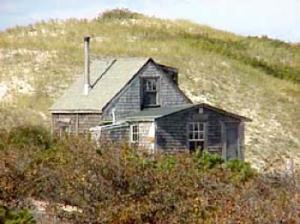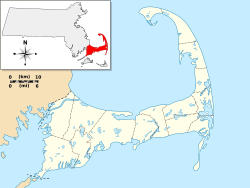Dune Shacks of Peaked Hill Bars Historic District facts for kids
Quick facts for kids |
|
|
Dune Shacks of Peaked Hill Bars Historic District
|
|

The dune shacks are but one part of this historic district that includes 1,960 acres of dunes
|
|
| Location | Cape Cod National Seashore |
|---|---|
| Nearest city | Provincetown, Massachusetts |
| Area | 1,950 acreas |
| Built | 1920 - 1960 |
| NRHP reference No. | 12000132 |
| Added to NRHP | March 15, 2012 |
The Dune Shacks of Peaked Hill Bars Historic District is a special place on Cape Cod in Massachusetts. It includes unique little houses called dune shacks. These shacks were once home to many famous American artists and writers. They lived there from the 1920s until today.
This historic area covers about 1,950 acres of sand dunes. It is part of the Cape Cod National Seashore. The district is located in the towns of Provincetown and Truro. It was added to the National Register of Historic Places in 2012. The name "Peaked Hill Bars" comes from an old Life-Saving Station that was built nearby in 1882.
History of the Dune Shacks
Before the current shacks were built, there were other small buildings in the dunes. These were for members of the United States Life-Saving Service. Their job was to help people who survived shipwrecks along the coast. The Massachusetts Humane Society built these early shacks. They offered shelter and supplies to sailors whose ships were wrecked in storms. The famous writer Henry David Thoreau even mentioned these dune shacks in his book Cape Cod (1865).
Around the 1920s, the shacks you see today started to appear. People say they were built using materials, or flotsam, that washed ashore from shipwrecks. Many artists and writers were drawn to the artist's community in Provincetown. They found these simple shacks appealing. They would live in the quiet, lonely dunes to write or paint.
One of the most famous people to stay in a shack was the playwright Eugene O'Neill. He bought one and spent many summers there. He wrote two of his famous plays, Anna Christie (1920) and The Hairy Ape (1921), while living in his shack. His presence made the dune shacks well-known among artists.
Other famous artists and writers also lived in these basic dune shacks. These included Harry Kemp, who called himself "the Poet of the Dunes." Also, Jack Kerouac, e. e. cummings, Norman Mailer, and Jackson Pollock stayed there. In 2016, musician and artist Jacob Bannon spent a week in a shack. He painted and recorded music, which became a book and album called Dunedevil. The shacks have always been very simple. They have never had electricity, plumbing, or running water.
Besides Thoreau, other writers also wrote about the dune shacks. Henry Beston wrote The Outermost House, which tells about a season he spent living in the dunes. Hazel Hawthorne-Werner wrote Salt House about her year in the dunes in 1929.
Today, there are 19 dune shacks in the historic district. The National Park Service owns 18 of them. Regular people can enter a lottery for a chance to stay in one of the shacks for a period of time. If you want to see the Dune Shacks, the only way to tour them is through Art's Dune Tours in Provincetown.
Dune Environment
Most of this historic district is an untouched dune landscape. It's not just about the shacks. A main goal of the historic district is to protect this beautiful dune environment. This landscape has inspired many artists over the years. You can also find many cranberry bogs here. These bogs form where natural underground water, called an aquifer, comes up through the low-lying dunes.
Origin of the Name
The name "Peaked Hill Bars" comes from one of the nine Life-Saving Service stations. These stations were set up on Cape Cod in 1882. Peaked Hill Bars later became a Coast Guard station, but it closed in 1938.
When they decided where to build the station, people said it was a very dangerous part of the coast. They called it an "ocean graveyard." There are hidden sandbars, called rips, that stretch far out into the sea. These bars can trap ships, and many terrible accidents happened there. There are two lines of these sandbars that are usually underwater. These bars are always moving and changing.


